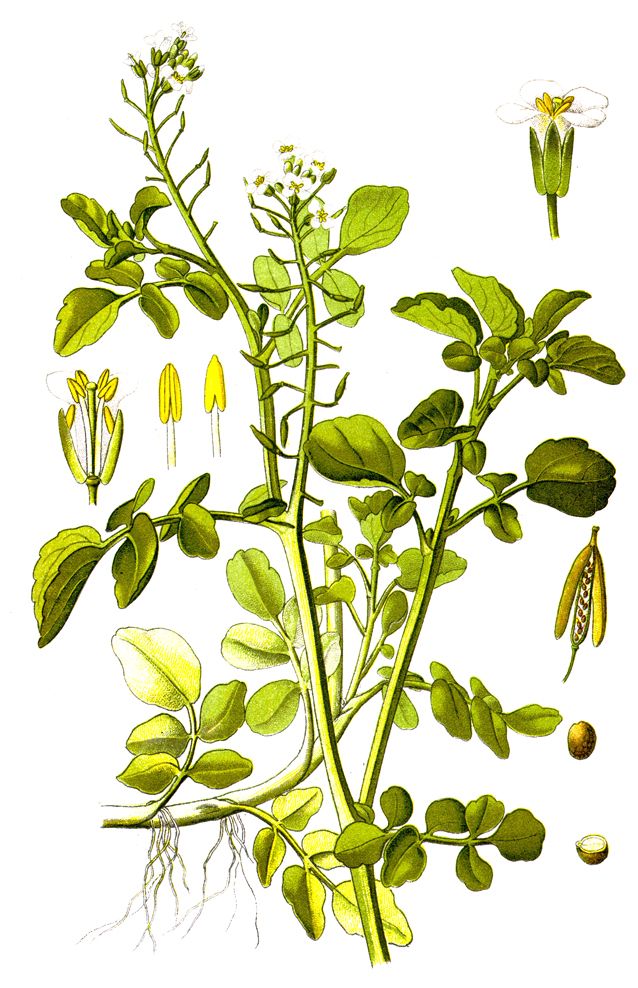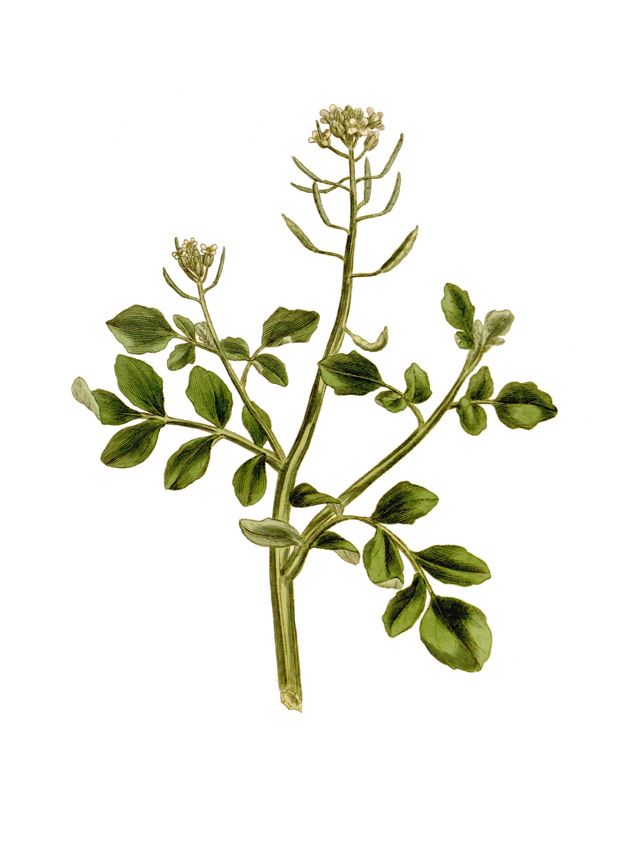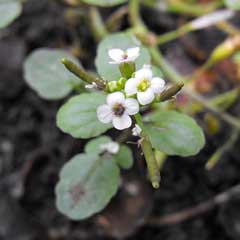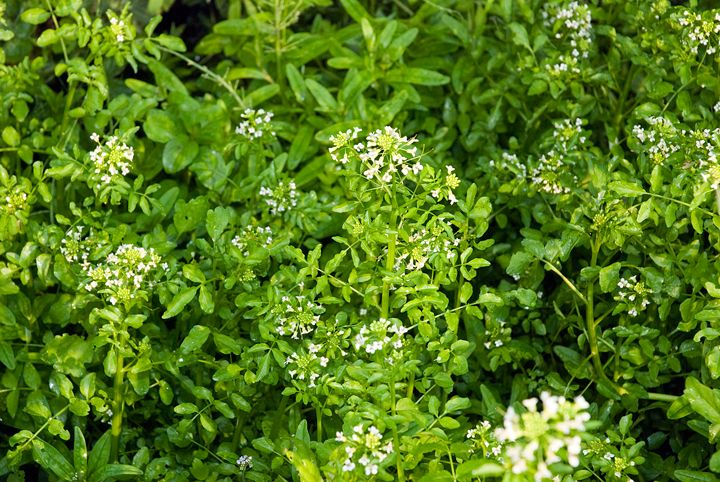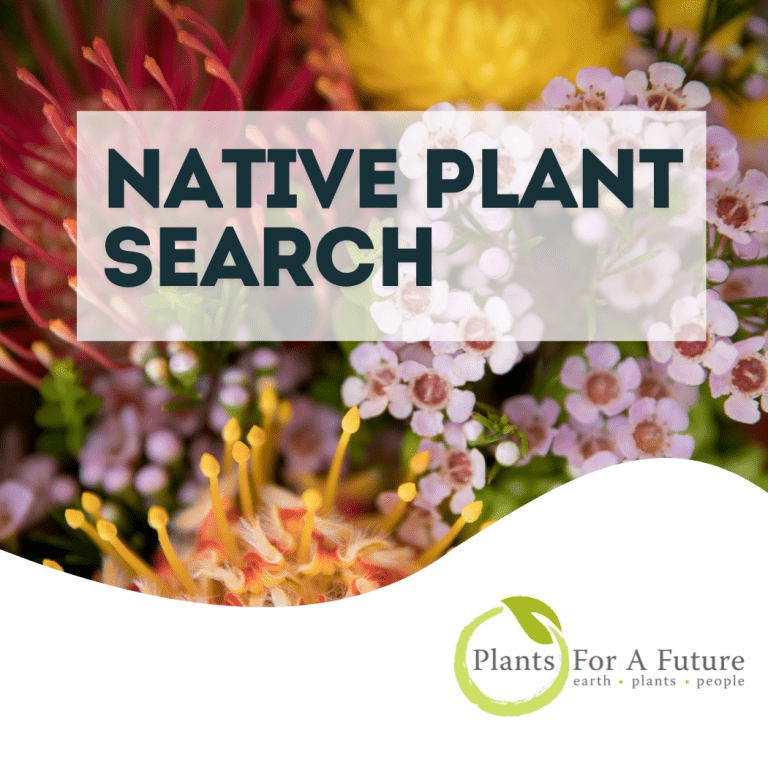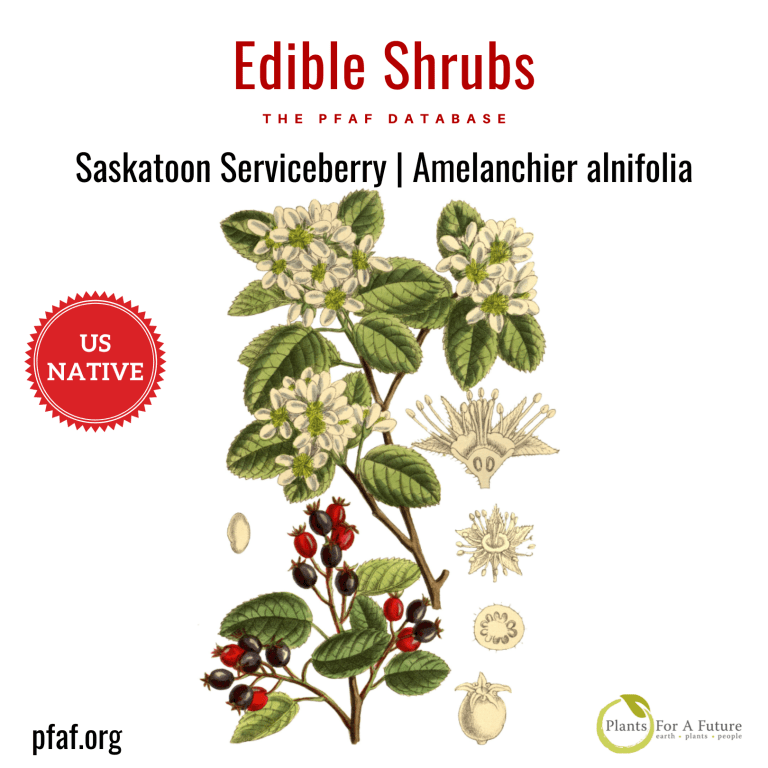
Watercress is mainly used as a garnish or as an addition to salads, the flavour is strong with a characteristic hotness. Leaves can be eaten raw or cooked. It has a reputation as a spring tonic, and this is its main season of use, though it can be harvested for most of the year and can give 10 pickings annually. Some caution is advised if gathering the plant from the wild, see the notes on toxicity. The leaves are exceptionally rich in vitamins and minerals, especially iron. The seed can be sprouted and eaten in salads; they have a hot mustardy flavour.
The seed can be ground into a powder and used as a mustard. The pungency of mustard develops when cold water is added to the ground-up seed – an enzyme (myrosin) acts on a glycoside (sinigrin) to produce a sulphur compound. The reaction takes 10 – 15 minutes. Mixing with hot water or vinegar, or adding salt, inhibits the enzyme and produces a mild but bitter mustard. Watercress is noted for attracting wildlife. It can be grown in containers. (Please note that it is a completely different plant to Land Cress or American cress which is Barbarea verna.)
Watercress is very rich in vitamins and minerals, and has long been valued as a food and medicinal plant. Considered a cleansing herb, its high content of vitamin C makes it a remedy that is particularly valuable for chronic illnesses. The leaves are antiscorbutic, depurative, diuretic, expectorant, purgative, antihypoglycaemic, odontalgic, stimulant and stomachic. The plant has been used as a specific in the treatment of TB. The freshly pressed juice has been used internally and externally in the treatment of chest and kidney complaints, chronic irritations and inflammations of the skin etc. Applied externally, it has a longstanding reputation as an effective hair tonic, helping to promote the growth of thick hair. A poultice of the leaves is said to be an effective treatment for healing glandular tumours or lymphatic swellings. Some caution is advised, excessive use of the plant can lead to stomach upsets. The leaves can be harvested almost throughout the year and are used fresh.
The juice of the plant is a nicotine solvent and is used as such on strong tobaccos.
Watercress is easily grown when given the correct conditions of slowly flowing clean water, preferably coming from chalky or limestone soils. The plant is very sensitive to pollution so an uncontaminated source of water is required. It prefers to grow in water about 5cm (2in) deep with an optimum pH of 7.2. Plants can be grown in wet soil if the position is somewhat shaded and protection is given in winter, though the flavour may be hotter. It is hardy to about -15°C (5°F). Plants will often continue to grow all through mild winters. A fast-growing plant, the stems trail along the ground or float in water and produce new roots at the leaf nodes, thus making the plant very easy to propagate vegetatively. Unfortunately, virus diseases have become more common in cultivated plants, and so most propagation is carried out by seed. This is a diploid species. It has hybridised naturally in the wild with the triploid species N. microphyllum to produce the sterile hybrid N. x sterilis which is also commonly cultivated as a salad crop. The flowers are a rich source of pollen and so are very attractive to bees.
Special Features: Attractive foliage, Edible, Not North American native, Wetlands plant, Flower characteristics are unknown.
Propagation: Seeds are sown in spring in a pot immersed to half its depth in water. Germination should take place within a couple of weeks. Prick out seedlings into individual pots whilst they are still small and increase the depth of water gradually until they are submerged. Plant out into a pond or shallow stream in the summer. Cuttings can be taken at any time in the growing season. Virtually any part of the plant, including a single leaf, will form roots if detached from the parent plant. Just put it in a container of water until the roots are well formed and then plant out in shallow water. It is possible to propagate from shop-bought plants. The watercress is placed in a dish of water until it roots (usually in about a week). The plants can then be added to the garden pond with the roots lodged under stones by the water’s edge. Watercress will grow successfully in static water and can be growing in containers with water or moist soil. The soil needs to be kept moist. It will spread and flower quickly.
Watercress. Scurvy Grass.
Nasturtium officinale – R.Br.
Family: Brassicaceae or Cruciferae
Known Hazards: Whilst the plant is very wholesome and nutritious, some care should be taken if harvesting it from the wild. Any plants growing in water that drains from fields where animals, particularly sheep, graze should not be used raw. This is due to the risk of it being infested with the liver fluke parasite. Cooking the leaves, however, will destroy any parasites and render the plant perfectly safe to eat. Watercress may inhibit the metabolism of paracetamol .
Natural Habitats: Stream margins, ditches, flushes etc with moving water, usually in chalk or limestone areas.
Natural Range: Europe, including Britain, from Sweden and Denmark south and east to N. Africa and W. Asia.
Hardiness Zones: USDA 3-11. UK 6. Is not frost tender.
Size: growing to 0.5 m (1ft-8in) by 1 m (3ft-3in)
Growth: F
Soil: light (sandy), medium (loamy) and heavy (clay) soils. It prefers wet soil and can grow in water.
Soil pH: acid, neutral and basic (alkaline) soils.
Light: It cannot grow in the shade.
Constituents: coumarins, fibre, folic acid, glycosides, protein with amino acids: arginine, histidine, isoleucine, leucine, lysine, threonine, phenylalanine, methionine, tryptophane, and valine. volatile oil
Vitamin: A, B1, B2, B3, B5, B6, B17, C, D, E, K
Minerals: calcium, chlorine, copper, florine, germanium, iodine, iron, magnesium, phosphorus, potassium, silica, sodium, sulphur, zinc
References: 2, 4, 5, 7, 9, 16, 17, 21, 27, 37, 46, 52,
56, 183, 200, 218, 238, 222, 244, 254, 264, 301
Edibility Rating: 4
Medicinal Rating: 3
Forest/Woodland Garden: Aquatic/Wetland
Layer, Herbaceous Layer
Database Page: http://www.pfaf.org/user/Plant.aspx?LatinName=Nasturtium+officinale
